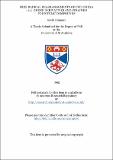Files in this item
Free radical rearrangements of cyclohexa-2,5-diene derivatives and strained polycyclic compounds
Item metadata
| dc.contributor.advisor | Walton, J. C. (John Christopher) | |
| dc.contributor.author | Binmore, Gavin | |
| dc.coverage.spatial | 187 p. | en_US |
| dc.date.accessioned | 2018-07-05T09:04:35Z | |
| dc.date.available | 2018-07-05T09:04:35Z | |
| dc.date.issued | 1995 | |
| dc.identifier.uri | https://hdl.handle.net/10023/14959 | |
| dc.description.abstract | Esters of cyclohexa-2,5-diene-l-carboxylic acid were investigated to study the transfer of the labile bisallylic hydrogens (C-4) to give the cyclohexadienyl radical and then the subsequent decarboxylative stage to give R •, the driving force being the rearomatisation of the benzene ring. The undesirable reaction, whereby hydrogen is abstracted from C-1, was prevented by the introduction of a methyl group into this position. The cyclohexa-2,5-diene-l-carboxylic acids are readily prepared by a Birch type reduction of benzoic acid. All the esters derived from cyclohexa-2,5-diene-l-carboxylic acid, were examined by EPR spectroscopy and showed the cyclohexadienyl radical. No decarboxylation was evident by this technique. Also investigated, by EPR spectroscopy, were the acids with different substituents at C-1, showing that for acids with highly stabilised alkyl substituents, decomposition occurs. Esters reacted with N- bromosuccinimide showed some of the desired bromides, formed after CO2 loss from the cyclohexadienyl radical. Esters forming non-stabilised radicals on decarboxylation have given the intended products in lower yields. The esters have also been examined in reactions with acrylonitrile, addition being observed to varying degrees. The radicals generated from 9-hydroxy- and 9-bromo-pentacyclo-[4.4.0.0 ²·⁵.0 ³⋅⁸.0 ⁴·⁷]nonane (homocubane) and for the same derivatives of pentacyclo- [4.4.0.0 ²·⁵.0 ³⋅⁸.0 ⁴·⁷]]decane (basketane) were observed by EPR spectroscopy. In spite of their very large strain energies both radicals rearranged extremely slowly and unrearranged products were obtained from homolytic reactions in solution at temperatures below 150°C. At higher temperatures the 9-basketyl radical rearranged by a cascade of three beta-scissions, the ultimate product being l-(4-cyclobut-2-enyl)cyclohexa-2,4-diene. The 9-homocubyl radical did not rearrange even at 220°C. Several reasons why these cage radicals rearrange at least six orders of magnitude more slowly than the related cubylcarbinyl radical are discussed. Photobromination of basketane yielded a mixture of four tetrabromides which were formed by bimolecular homolytic substitution at every bridgehead. Norcubylcarbinyl radicals, that were generated by bromine abstraction from norcubylcarbinyl bromide, rearranged so rapidly that only the product of β-scission, 6-methylenebicyclo[3.1.1]hept-3-yl, could be observed by EPR spectroscopy. The rate constant for β-scission was estimated from the EPR experiments, and from reductions of norcubylcarbinyl bromide with tributyltin hydride, to be > 5x10⁹s-l at 298K. A series of 3-substituted bicyclo[l.l.l]pent-l-yl radicals, including the 3-fluoro-derivative, was generated by bromine atom abstraction from l-bromo-3-substituted- bicyclo[l.l.l]pentanes and examined by EPR spectroscopy. The exceptionally large hyperfine splittings obtained from magnetic nuclei of the 3-substituents indicated that crosscage electronic interactions were substantial in these species. Bromine atom abstraction by triethylsilyl radicals from l-bromo-3-fluorobicyclo[l.l.l]pentane was found to take place more rapidly than bromine abstraction from the unsubstituted parent, i.e. the fluorine substituent mediated a significant polar effect. Evidence was found of a novel disproportionation process in which the γ-fluorine atom was transferred from the 3-fluoro-radical to a triethylsilyl or to a second bicyclo[l.l.l]pent-l-yl radical; an analogous chlorine atom transfer process was found for the 3-chloro-radical. 4-Substituted bicyclo[2.2.2]oct-l-yl radicals were generated by bromine atom abstraction from the corresponding l-bromobicyclo[2.2.2]octanes and observed in solution by EPR spectroscopy. The EPR data indicated that 4-substituents exercised a significant effect at the radical centre, mainly by a through bond mechanism. 10-Substituted triptycyl radicals were generated in a similar way but showed no hfs from magnetic nuclei of the substituents. Bicyclo[2.2.2]oct-l-yl radicals were added to benzene, tert-butylbenzene and 1,3-di-tert-butylbenzene to give cyclohexadienyl radicals which were characterised by EPR spectroscopy. The bicyclo[2.2.2]oct-l-yl radical generated in rerr-butylbenzene showed exclusive meta addition with formation of the corresponding l-polycyclo-3-tert-butylcyclohexadienyl radical. | en_US |
| dc.language.iso | en | en_US |
| dc.publisher | University of St Andrews | |
| dc.subject.lcc | QD305.H8B5 | |
| dc.subject.lcsh | Acetylene compounds | en |
| dc.title | Free radical rearrangements of cyclohexa-2,5-diene derivatives and strained polycyclic compounds | en_US |
| dc.type | Thesis | en_US |
| dc.contributor.sponsor | R. S. Lumsden | en_US |
| dc.type.qualificationlevel | Doctoral | en_US |
| dc.type.qualificationname | PhD Doctor of Philosophy | en_US |
| dc.publisher.institution | The University of St Andrews | en_US |
This item appears in the following Collection(s)
Items in the St Andrews Research Repository are protected by copyright, with all rights reserved, unless otherwise indicated.

